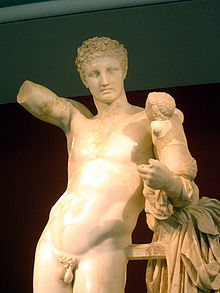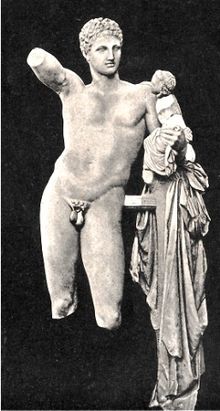Hermes of Olympia
The Hermes of Olympia is a marble group of the Greek god Hermes with the Dionysus boy on his arm. It is around 340 BC. And is at the transition from the late Classical to the early Hellenism in Greek art . The sculpture is attributed to the sculptor Praxiteles . It is in the Museum of Olympia . The lower legs of the statue are now supplemented. The statue was found on May 8, 1877 during excavations in the cella of the Temple of Hera in Olympia under the direction of Gustav Hirschfeld . This find was a sensation in archeology . Since Pausanias (5, 17, 3) mentions this statue in the Heraion at Olympia in the 2nd century AD, it can be assumed that the group of statues was found at its original location.
The right leg and the tree trunk support the composition. The tree trunk with the robe thrown over it contrasts with the smooth body of the god. The propped up left arm, which carries the little Dionysus, corresponded to the raised right arm, whose hand presumably held out a bunch of grapes to the boy. The ponderation of the body, i.e. the swing of the hips and the relationship between the standing leg and the free leg as a counter-post, reveals the influence of the classical sculpture school according to Polyklet , the leg proportions of Hermes the stylistic influence of Lysipp , who was a pupil of Polyklet.
This group of statues has been the cause of much controversy since it was found. Some archaeologists believed that because of the arrangement of the tree support, the folds of the robe and the smooth polishing of the surface of the marble, Hermes is a Roman copy of a Greek original. The debate started in 1927 by Carl Blümel . His approach is remarkable in that he not only included style-critical arguments in his discussion, but also raised technical questions regarding sculpture. Since he was also a sculptor himself, these observations were particularly important. Others, however, attest to its Greek originality. The base, which was also found there and on which the statue in the Museum of Olympia stands, is dated to the 2nd or 1st century BC by the building researcher William Bell Dinsmoor . Dated - significantly earlier than would be considered for a Roman copy of the statue. This question has not been definitively clarified, but today science tends more to believe that it is an original of the Praxiteles.
literature
- Carl Blümel : Greek sculpture work . de Gruyter, Berlin 1927.
- Carl Blümel: The Hermes of a Praxiteles . Klein, Baden-Baden 1948.
- Albert Kreuzer: The Praxiteles Hermes of Olympia . de Gruyter, Berlin 1948.
- The question of whether the statue is the original of the Praxiteles or a copy is discussed in detail in the American Journal of Archeology , Volume 35, 1931, in individual articles by: Rhys Carpenter 249-261, Stanley Casson 262-268, Carl Blümel 269-276, Gisela MA Richter 277 - 290, Valentin Müller 291 - 295, William Bell Dinsmoor 296 - 297.
Web links
- http://www.ksbuelach.ch/fach/as/material/kg_gr/plastik/pl16.htm
- Hermes with the Dionysus boy ( Memento from April 20, 2015 in the Internet Archive )
- Hermes of Olympia in the Arachne archaeological database

